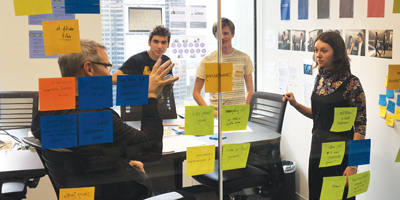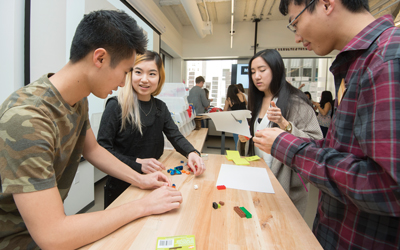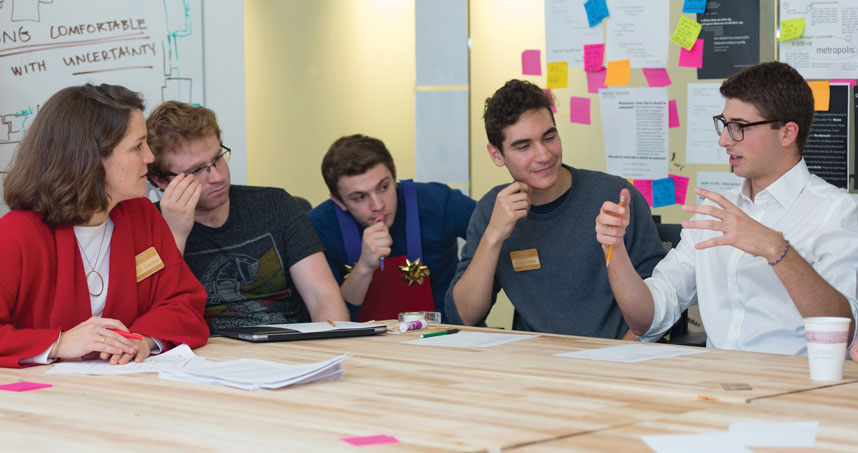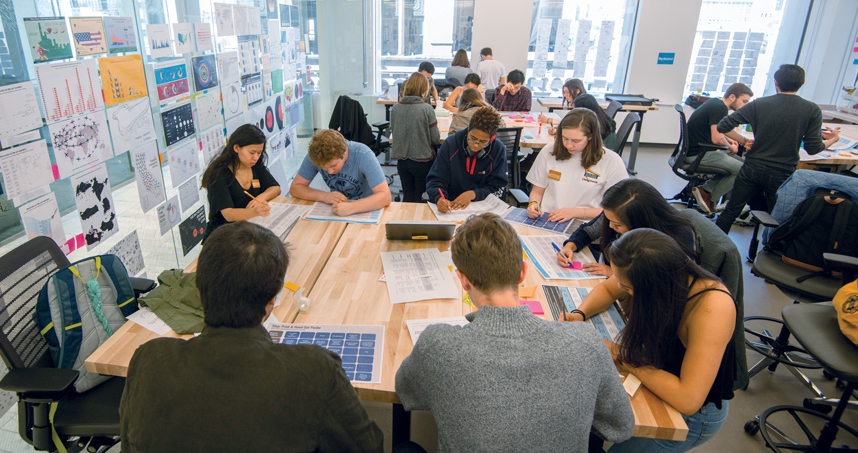Immersed in Innovation, Engineering Meets Journalism
New Bay Area Immersion Experience sends journalists and engineers to America’s startup capital for a true whole-brain experience.
Each morning, James Xie leaves his apartment on Telegraph Hill and walks through San Francisco’s Chinatown headed to 44 Montgomery Street, just off of Market Street in the heart of the Financial District.
There, on the 18th floor in offices offering a 360-degree view of the city, he meets with his peers. Standing in front of hanging sticky notes arranged in the shape of a soccer goal, the group discusses the tasks of the day—meeting with startup executives perhaps, or developing a project to engage more Facebook users in political activism.
Xie isn’t a Northwestern graduate working at a tech company, or even a full-time intern. He’s part of the first cohort of Northwestern’s new Bay Area Immersion Experience. Its goal: immerse 23 engineering and journalism students in San Francisco’s unique culture at the dynamic intersection of media, journalism, and technology.
“It feels like I’m going to a job,” says Xie, a Northwestern Engineering sophomore majoring in computer science. “It’s a preview of adult life.”
“It 100 percent does not feel like I’m in college,” says Sasha Costello, a junior in the Medill School of Journalism, Media, Integrated Marketing Communications. “It’s not a vacation quarter. There’s a lot of work, but the work consumes your life in a good way.”
Courtship of McCormick and Medill
The Immersion Experience, first offered in winter quarter 2017, is a natural extension of the ongoing collaboration between Medill and McCormick. The two schools’ partnership began in 2011 with the Knight Lab, which creates technologies for media, and NUvention Web + Media, an entrepreneurship class in which students create web-based businesses.
“Abstractly, both journalism and engineering are about under- standing a situation and acting on it,” says Elizabeth Gerber, Charles Deering McCormick Professor of Teaching Excellence and associate professor of mechanical engineering and communication studies. “The concerns of both studies are now so intertwined. The production and distribution of information is almost always technologically mediated. It’s getting more difficult to see the distinction between the two disciplines.”
The San Francisco program is the new millennium’s iteration of Medill’s 50-year-old tradition of sending student journalists to Washington, D.C., for a quarter to immerse them in experiencing that city’s distinctive culture and covering stories of international importance.
“Just as it does in D.C., what happens in the Bay Area and Silicon Valley touches every American, in fact, everyone in the world,” says Owen Youngman, Medill professor and Knight Chair in Digital Media Strategy.
Rooted in the Whole-Brain Approach
 The cohort of this beta program included 11 students from McCormick, 11 from Medill, and one from the School of Education and Social Policy, chosen from dozens of applicants. In fall quarter 2016, most of the selected students took JOUR 390: Media Innovation and Chicago’s Startup Scene with Youngman, meeting both at Medill and in The Garage, Northwestern’s tech incubation space. That class introduced them to the tech industry’s business practices and ideas, preparing them to hit the ground running once they arrived on the West Coast.
The cohort of this beta program included 11 students from McCormick, 11 from Medill, and one from the School of Education and Social Policy, chosen from dozens of applicants. In fall quarter 2016, most of the selected students took JOUR 390: Media Innovation and Chicago’s Startup Scene with Youngman, meeting both at Medill and in The Garage, Northwestern’s tech incubation space. That class introduced them to the tech industry’s business practices and ideas, preparing them to hit the ground running once they arrived on the West Coast.
Once there, on Montgomery Street, all 23 students took the same four classes: two focused on media and two on design innovation— aiming to create a whole-brain experience for both sets of students. Each class had dedicated space, and no other sections of class moved through the space. “That brings a different feel, almost like elementary school,” Costello says. “We hang up our work on the walls. It looks like it is really our room.”
Gerber taught both design classes. In Communication Design, students learned to design information to elicit a desired response using data visualization and other methods. “It speaks to both groups—engineers and journalists. They learn how to make sense of a large amount of data, the fundamentals of information layout, and what pictograms are universally understood,” she says.
“It’s going to be the most useful class I take at Northwestern University,” Xie says. “I made a poster at the beginning of this quarter. Now, I look at it and think, ‘That is god-awful.’ I’ve changed. I realize if you have a great idea and can’t communicate it, it’s worthless.”
Encouraging Activism
The Design Innovation Practicum focused on service design. One assignment looked at social media and civic engagement. Gerber charged student teams with helping people use Facebook to organize political involvement. Costello’s fourperson team, which included one other journalist and two engineers, created a Facebook feature called Political Pokes. A more personal interaction than group pages, the widget nudges people to go to protests, participate in marches, or sign petitions.
“We made journey maps and stakeholder maps,” Costello says. “That’s where my journalism background helped. We interviewed people and did research on who was affected by what we were creating. That’s all stuff I knew how to do.”
For the practicum in particular, the Montgomery Street location made all the difference, Xie says. “There was so much political action right there in San Francisco, with all the protests going down Market Street. We could walk two minutes in one direction, and we were in the middle of the protest where we could talk to the people involved.”
Because all 23 students took all four classes, the curriculum connected in a unique way. “I could spend more time on each topic instead of repeating things to each class,” Gerber says. “We could blend assignments, reinforce information, and make learning more efficient for them. For me as a teacher, that’s terribly satisfying.”
“Dr. Liz is probably the most incredible teacher I ever studied with. She encouraged us to think differently,” says Mikowai Ashwill, a junior double majoring in music performance and industrial engineering. “Her classes broke me out of the rut of engineering. They opened my mind to be creative and think in a different way.”
Pressures and Pitfalls
Youngman’s long-standing class, The Googlization of American Media, doubled as a technological experiment, with the former Chicago Tribune senior vice president splitting his time between the two campuses—with students in each place.
In adjunct lecturer Marcia Parker’s class, Media Innovation in Silicon Valley, students went on field trips every other week to visit local startup companies or to attend conferences, including Startup Grind in Redwood City. There, students rubbed elbows with more than 5,000 attendees and heard a variety of speakers, including Elena Grewal of Airbnb; Jan Koum, CEO of WhatsApp; and Hamdi Ulukaya, chairman and CEO of Chobani.
Startup founders and executives regularly visited the classes to talk about the opportunities their work presents, as well as the pressures and pitfalls. “I learned that almost no one studied in college what they ended up doing as a career,” Xie says. “I now see there is a lot of possibility for learning. Learning doesn’t end after college.
“This is a super volatile environment, where companies come and go,” observes Xie, who wants to return to Silicon Valley after graduation. “It will be stressful.”
“Developing interaction skills—how to interact with others effectively—is key to this program. I want students to fundamentally believe in the power of community to try out ideas that are not perfectly formed and then get honest feedback.”
Tapping Area Wildcats
The program tapped Bay Area Northwestern alumni as advisers on student projects. Pete Mortensen (Medill ’03), a partner at Matter Ventures, for example, consulted on an assignment concerning changing media for good.
“We were connecting with alums who don’t see Northwestern sweatshirts when they walk the street every day. They loved it. It was like a welcome home party,” Gerber says.
The alumni provided inspiration too. Andrew Prince (Medill ’08), a content strategist at Instagram, advised on the Facebook political activism project. “He talked to us about being a content strategist, and now I think it’s awesome,” Costello says. “It’s what I want to do when I graduate.”
Power of Community
 Class meeting times ranged from 90 minutes to four hours. Group work typically filled the rest of the day, sometimes into the evening. “In Evanston, everyone has entirely different schedules, and it is so hard to meet up,” Xie says. “In San Francisco, everyone was present at every meeting.”
Class meeting times ranged from 90 minutes to four hours. Group work typically filled the rest of the day, sometimes into the evening. “In Evanston, everyone has entirely different schedules, and it is so hard to meet up,” Xie says. “In San Francisco, everyone was present at every meeting.”
All three students admitted the amount of collaboration and group work was intense, but each valued the experience. “Through these classes, I saw how helpful it is to work in a team with people from different backgrounds. You clearly see the same things differently, and amazing things can happen when you brainstorm together. The solutions are much more creative,” Costello says.
As intimacy developed among the students, so did the confidence to offer honest, constructive criticism. “Developing interaction skills—how to interact with others effectively—is key to this program,” Gerber says. “I want students to fundamentally believe in the power of community to try out ideas that are not perfectly formed and then get honest feedback.”
Montgomery Street has a very different feel than the Evanston campus. “We knew it would. In a way it is less stressful, but it is also more tiring for the students,” Youngman says.
Prepared for What's Next
Some students decided to extend their experience to include part-time internships. Xie coded for Meedan, a software company that builds tools for journalism. Ashwill worked at Owlized, a startup specializing in virtual reality. Others took on side projects, working with their professors.
While the palm trees and temperate weather convinced several students to return to the Bay after graduation, the hope is that others will bring their expertise back to Chicago and serve as leaders in the Midwest, Youngman says. “Tech is a different but important culture in the Midwest.”
With the quarter winding down and Youngman and Gerber planning for next year’s cohort, the students of the beta version of the program were impressed. “I was honestly not expecting it to be so well organized,” Costello says. “Dr. Liz constantly asked us for feedback about what could be better, and she tailored each class based on that.”
“I grew leaps and bounds in coding experience,” Xie says. “But that’s not all. I have a new community. And the biggest thing is I have a new perspective. I have been able to get a much better grasp of life in general and what I want to do next.”


